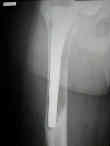- Discussion:
- evaluation of the painful THR
- indications for revision
- evaluation for loosening
- outcomes:
- references:
- Why revision total hip arthroplasty fails.
- Revision Hip Arthroplasty: Infection is the Most Common Cause of Failure
- Examination:
- examination for loosening:
- previoius incisions;
- contracture of the flexors and adductors (adds to complexity of the case);
- impingement: tenderness to forced internal rotation may indicate anterior impingement;

- leg-length inequality is noted;
- ref: Surgical Treatment of Limb-Length Discrepancy Following Total Hip Arthroplasty.
- neurovascular status of the limbs is recorded (EMG can be ordered if necessary);
- trendelenburg gait:
- power of the abductor muscles is noted;
- marked Trendelenburg gait may indicate that abductors are non functional;
- may be due to paralysis or loss of continuity;
- if no trochanteric frx is present, then consider EMG to evaluate for paralysis;
- PreOp Planning: (radiographs, equipment, implant selection);
- radiographs
- extraction instruments
- selection of implants:
- components for acetabular revision
- femoral cementless revision
- cemented femoral revision
- rule out infection:
- besides ruling out joint infection, consider culture of nares since preoperative staph aureus nasal carriage is associated
w/ postop infection;
- references:
- Revision operations on infected total hip arthroplasties. Two- to nine-year follow-up study.
- The value of aspiration of the hip joint before revision total hip arthroplasty.
- Perioperative Antibiotics Should Not Be Withheld in Proven Cases of Periprosthetic Infection.
- Sonication of Removed Hip and Knee Prostheses for Diagnosis of Infection
- give prophylactic antibiotics in normal fashion;
- ref: Perioperative Antibiotics Should Not Be Withheld in Proven Cases of Periprosthetic Infection.
- sciatic nerve is identified:
- Incidence of Sciatic Nerve Palsy After Revision Hip Arthroplasty Through a Posterior Approach
- soft tissue release is extensive so that manual force can be minimal during dislocation;
- partial release of the psoas tendon;
- partial release of gluteus maximus insertion;
- release of reflected head of the rectus femorus;
- references:
- A new approach to the hip for revision surgery.
- A technique of extensile exposure for total hip arthroplasty.
- Extensile exposure of the hip for revision arthroplasty.
- surgical dislocation of hip;
- because femur usually has been weakened owing to cortical defects or cavitation, great care is taken in dislocating hip and exposing
femur to avoid fracture;
- greater trochanter osteotomy will facilatitate dislocation;
- the entire pseudocapsule is excised or released;
- need for tissue biopsy cultures from the component membrane interface
- remember that in the case of biofilm, there may be minimal infection in joint fluid and capsule, and the main area of infection
will be over the component /bone-membrane interface;
- consider adding tissue culture (or at least saline) to the tissue sample inorder to improve true positive results;
- references:
- A comprehensive microbiological evaluation of fifty-four patients undergoing revision surgery due to prosthetic joint loosening.
- The fate of the unexpected positive intraoperative cultures after revision total knee arthroplasty
- The Chitranjan Ranawat Award: Should prophylactic antibiotics be withheld before revision surgery to obtain appropriate cultures?
- Use of broth cultures peri-operatively to optimise the microbiological diagnosis of musculoskeletal implant infections.
- femoral component revision;
- trochanteric osteotomy
- acetabular component revision:
- exposure of acetabulum:
- requires wide exposure of hip w/ removal of pseudocapsule, exposing entire proximal end of femur & entire
circumference of acetabulum to permit careful implant removal;
- references:
- A new approach to the hip for revision surgery.
- A technique of extensile exposure for total hip arthroplasty.
- Extensile exposure of the hip for revision arthroplasty.
- retention of acetabular shell:
- in some revision situations, the acetabular cup is noted to be stable and is left in place (ie only femoral revision is performed);
- references:
- Fate of Cementless Acetabular Components Retained During Revision Total Hip Arthroplasty.
- Cementing a Liner into a Stable Cementless Acetabular Shell: The Double-Socket Technique.
- Cementation of a Polyethylene Liner Into a Metal Shell
- Cementation of a Metal-Inlay Polyethylene Liner Into a Stable Metal Shell in Revision Total Hip Arthroplasty.
- Cementing Acetabular Liners Into Secure Cementless Shells for Polyethylene Wear Provides Durable Mid-term Fixation
- Long-Term Outcomes of Liner Cementation into a Stable Retained Shell: A Concise Follow-up of a Previous Report.
- removal of acetabular components
- grafting of acetabular defects
- management of pelvic discontinuity
- Post Op Anesthesia:
- Local Analgesia Infiltration Techniques – Hip and Knee Arthroplasty
Revision total hip arthroplasty
Long-term results of revision total hip replacement. A follow-up report.
Multiple revisions for failed total hip arthroplasty not associated with infection.
Component removal in revision total hip arthroplasty.
The Fate of Well Fixed Cemented Femoral Components Left in Place at the Time of Revision of the Acetabular Component.
Results of revision for mechanical failure after cemented total hip replacement, 1979 to 1982. A two to five-year follow-up.
The Diagnostic and Predictive Value of Hip Anesthetic Arthrograms in Selected Patients Before Total Hip Arthroplasty.
Fixation of hydroxyapatite-coated revision implants is improved by the surgical technique of cracking the sclerotic bone rim.

